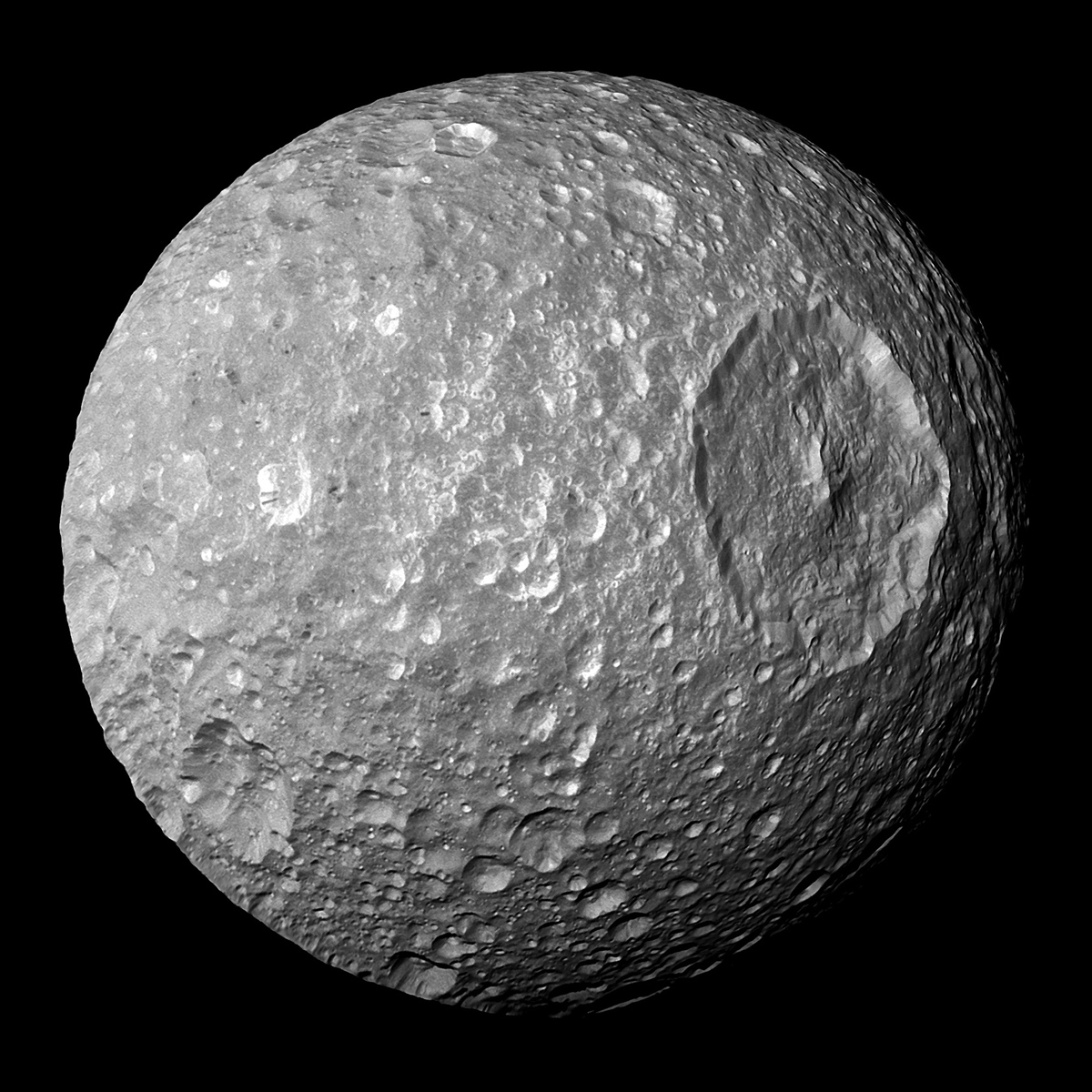

WEEK 25: JUNE 14-20
TOPIC: LUNAR AND PLANETARY IMPACTS
Ever since the Italian astronomer Galileo Galilei turned his primitive telescope towards the moon on November 30, 1609 and saw them for the first time, we’ve known that the moon is covered with craters. These come in all sizes, from very large ones several hundred km across down to meter-size and smaller. For a long time following their first detection the physical mechanism responsible for the craters was long debated, with some researchers arguing for an impact origin and others arguing for a volcanic origin or some other mechanism (including glacial activity). By the middle decades of the 20th Century the impact origin theory was gaining a stronger and stronger foothold among scientists – especially after impact craters on Earth began to be positively identified as such – and once rock and soil samples brought to Earth by the Apollo astronauts were analyzed these conclusively established this theory as being correct. It is now apparent that the overwhelming majority, if not almost all, of craters on the moon are the result of impact events.
Unlike Earth, the moon does not have any kind of substantial atmosphere, and thus any objects that intercept the moon would do so unimpeded, whereas most smaller objects will disintegrate in Earth’s atmosphere. While larger objects would still survive their passage through Earth’s atmosphere and strike the surface leaving impact craters – at least, those striking the land surface would do so – active geological processes like plate tectonics and weathering act to remove those craters within a geologically short period of time. The moon, however, is a geologically “dead” place where such processes are not operating, and thus craters formed by impacts would remain indefinitely. Thus, the large number of such craters on the moon compared to Earth – despite the fact that Earth presents almost 13 times the surface area to impacting objects that the moon does.
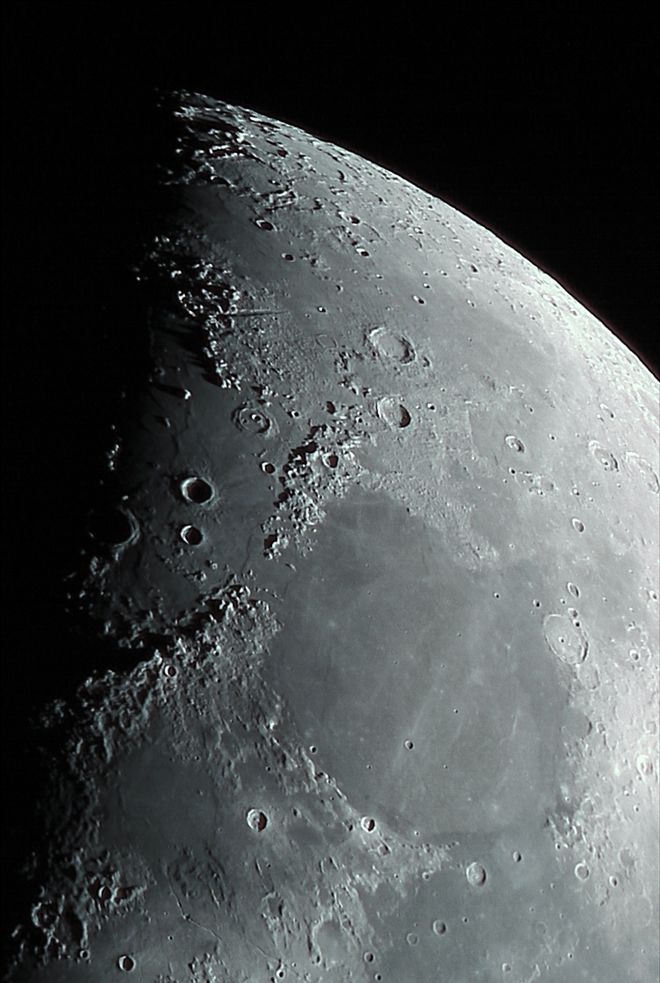
 Two views of the cratered lunar surface. Left: From Earth. Image courtesy Joe R. of Austin, Texas. Right: From lunar orbit. The famous “Earthrise” image taken by Apollo 8 astronaut William Anders on December 24, 1968. Courtesy NASA.
Two views of the cratered lunar surface. Left: From Earth. Image courtesy Joe R. of Austin, Texas. Right: From lunar orbit. The famous “Earthrise” image taken by Apollo 8 astronaut William Anders on December 24, 1968. Courtesy NASA.
The one process operating on the moon that tends to “erode” craters is the continuing impacts by additional objects. Older craters will accordingly be “over-written” by younger craters where more recent objects have struck the same basic geological location. Since the ejecta from impacts will themselves rain down upon the lunar surface relatively nearby the original impact, older craters will also tend to be “over-written” by these smaller “satellite” craters. Based upon expected rates of impact events, it is possible to make approximate determinations of a crater’s age by examining the amount of “impact erosion” it has experienced.
In addition to their erosive effects on older craters and to their accompanying systems of “satellite” craters, younger craters are also often accompanied by systems of lighter-colored “rays” radiating out from them. These are caused by lighter-mass ejecta material (pebbles and dust) raining down onto the lunar surface following the impact. Copernicus (approximate age 800 million years) and Tycho (approximate age 108 million years) are craters with prominent ray systems; that of Tycho is especially prominent around the time of full moon.

We would obviously expect the moon to continue being struck by impacting objects from time to time. During the Leonid meteor storm on November 18, 1999 – which will be discussed in a future “Special Topics” presentation – at least five brief flashes of light were detected on the moon’s unlit portion, these apparently being due to meteoroids from the Leonid stream striking the moon’s surface. A NASA-operated program to detect meteoroid impacts on the unlit portion of the near-side lunar surface began operations in 2006 and has recorded numerous such events; the brightest (and apparently) largest such event occurred in the Mare Imbrium on March 17, 2013, apparently caused by an object 30 to 40 cm across with an approximate mass of 40 kg. Just over four months later NASA’s Lunar Reconnaissance Orbiter (LRO) spacecraft detected a brand new 18-meter-wide crater – complete with a system of rays several km long – at the site of this event.
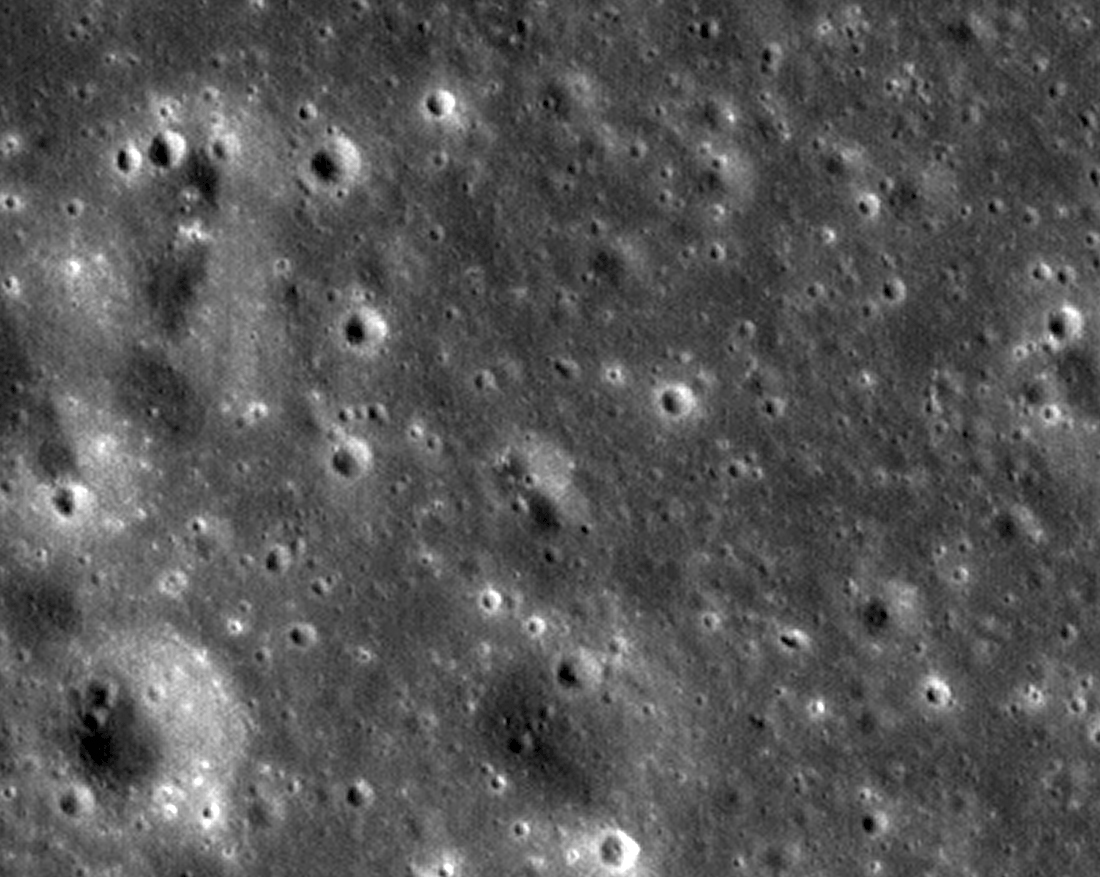
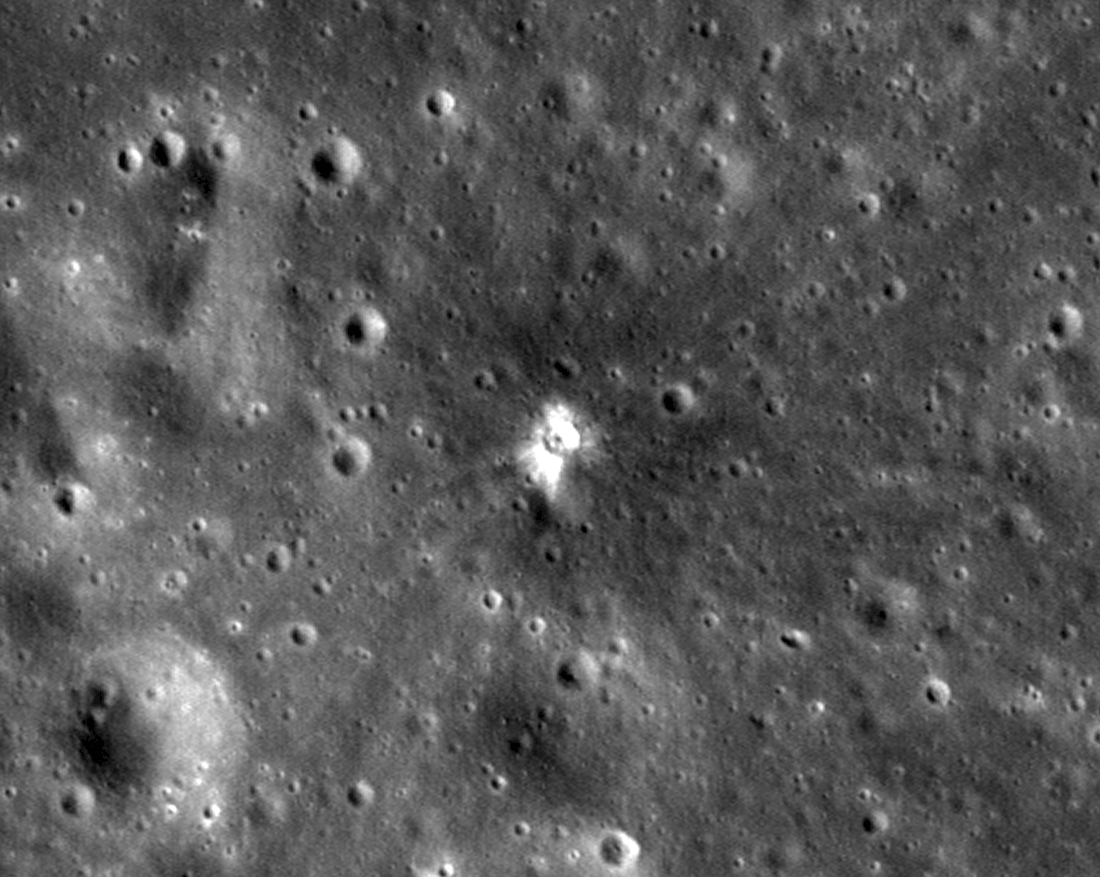 “Before” (left) and “after” (right) images taken by NASA’s Lunar Reconnaissance Orbiter (LRO) mission of the March 17, 2013 impact in the Mare Imbrium. The “before” image was taken on February 12, 2012 and the “after” image was taken on July 28, 2013. Both images courtesy NASA.
“Before” (left) and “after” (right) images taken by NASA’s Lunar Reconnaissance Orbiter (LRO) mission of the March 17, 2013 impact in the Mare Imbrium. The “before” image was taken on February 12, 2012 and the “after” image was taken on July 28, 2013. Both images courtesy NASA.
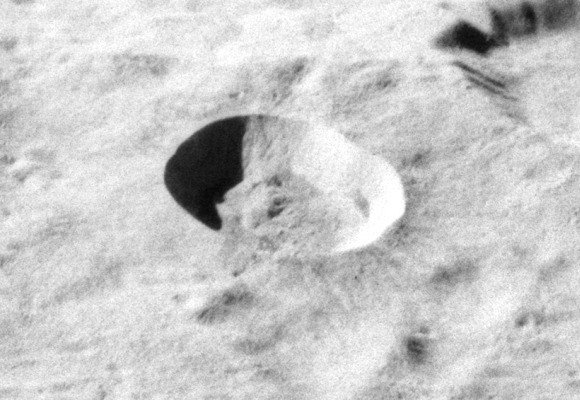
Since the beginning of the Space Age there have been several small lunar craters created by the deliberate impacts of spacecraft onto the lunar surface, beginning with the then-Soviet Union’s Luna 2 spacecraft on September 13, 1959 and which included several probes of NASA’s Ranger series between 1962 and 1965. The most scientifically ambitious mission involving a lunar impact was NASA’s Lunar CRater Observation and Sensing Satellite (LCROSS) mission, which was launched (together with LRO) on June 18, 2009. LCROSS’ mission plan called for it to impact a permanently-shadowed crater near the moon’s south pole in an attempt to detect the presence of water ice (the presence of which had first been suspected in radar experiments conducted with the joint NASA/U.S. Defense Department lunar-orbiting Clementine mission in 1994). LCROSS’s Centaur booster successfully impacted the lunar surface in the crater Cabeus on October 9, 2009, and the accompanying “Shepherding Spacecraft” successfully detected the presence of water in the impact plume before its own impact a few minutes later. (The reasons for water’s presence in such an environment are discussed in a future “Special Topics” presentation.)
The moon, of course, is not the only body that gets struck by impacting asteroids and comets; the various other worlds of our solar system are struck as well. I’ve already mentioned that Earth gets struck; the existence of meteorites (discussed in a couple of previous “Special Topics” presentations) proves that, as does the existence of various terrestrial impact craters, such as the Chicxulub crater in Mexico that marks the site of the K-T impact (discussed in another previous “Special Topics” presentation) and other craters that are the subject of a future “Special Topics” presentation.
Venus’ dense atmosphere prevents smaller objects from hitting the surface, and weak (although nevertheless ongoing) volcanic activity and other geological processes tend to erase surface craters after a few hundred million years. About a thousand impact craters have been identified on Venus’ surface, the largest of these being Mead with an approximate diameter of 280 km.
.png)
Over 40,000 impact craters down to a diameter of 5 km have been identified on Mars’ surface, and there are certainly many times this number of smaller craters. Martian craters have figured in the surface exploration of the planet; the Spirit rover, which landed in January 2004, did so in the crater Gusev, an old evolved crater some 166 km in diameter, while Opportunity, which landed that same month, explored several craters during its 14 years of exploration, the largest of these being Endeavour (diameter 22 km). The Curiosity rover has been exploring the crater Gale (diameter 154 km) ever since its touchdown in August 2012. Meanwhile, new Martian craters are appearing all the time; in one dramatic incident, on March 28, 2012 NASA’s Mars Reconnaissance Orbiter (MRO) spacecraft detected a fresh 50-meter-wide impact crater – surrounded by several smaller fresh craters – near the Martian Equator south-southwest of Olympus Mons, however these craters did not appear in images taken the previous day, thus allowing the time of impact to be narrowed down to within a one-day period.
 Ground-based panorama mosaic of Mars’ crater Victoria (diameter 750 meters) taken by the Opportunity rover from the northwestern rim between October 16 and November 6, 2006. Image courtesy NASA.
Ground-based panorama mosaic of Mars’ crater Victoria (diameter 750 meters) taken by the Opportunity rover from the northwestern rim between October 16 and November 6, 2006. Image courtesy NASA.
One would expect Jupiter, with its large size and mass (and thus large gravitational field) to experience numerous impacts on a regular basis, although because Jupiter has no solid surface there are obviously no impact craters. Impacts onto Jupiter have nevertheless been detected, by far the most dramatic of these being those of the fragments of Comet Shoemaker-Levy 9 1993e during July 1994. This comet is a future “Comet of the Week” and these impacts, and impacts onto Jupiter in general, are discussed in that presentation.
The various planets’ moons, along with the solar system’s other “small bodies,” are also subject to impacts, and when appropriate these events are discussed in other “Special Topics” presentations. Those moons that are geologically active in some way do not have many impact craters, for obvious reasons; indeed, Io (Jupiter I), because of its continuous extensive volcanic activity, has essentially no impact craters, and Europa (Jupiter II), with its likely sub-surface liquid water ocean, has relatively few craters. Other geologically active moons with few craters are Enceladus (Saturn II) which exhibits ongoing geyser activity over parts of its surface; Titan (Saturn VI) which in addition to an active geology also has a dense atmosphere to stop smaller objects; Miranda (Uranus V) which exhibits evidence of (geologically) recent cryovolcanism over some regions of its surface; and Triton (Neptune I) which, as is the case with Enceladus, exhibits ongoing geyser activity. (It is possible, incidentally, that Triton is a captured object from the Kuiper Belt, something that will be discussed in a future “Special Topics” presentation.) The Sputnik Planitia region of Pluto has a very fresh surface indicative of very (geologically) recent geological activity, and the New Horizons mission detected no craters within it, although it detected quite a few craters elsewhere on Pluto’s surface.
Most of the other moons that have been examined in detail exhibit relatively heavily cratered surfaces. Indeed, Ganymede (Jupiter III) and Callisto (Jupiter IV) exhibit “chains” of craters that are possibly indicative of impacts by fragmented comets like Shoemaker-Levy 9. One rather interesting example of an impact crater is found on Mimas (Saturn I), which exhibits one very large crater, named Herschel, with a diameter of 139 km (Mimas itself having an average diameter of 396 km). On the first images of Mimas returned by Voyager 1 during its passage by Saturn in 1980 the presence of Herschel gave it an appearance strikingly reminiscent of the “Death Star” that was in the movie “Star Wars” three years earlier. In a real sense this could be considered a classic example of “life imitating art.”
“Special Topics” archive
Ice and Stone 2020 home page
Earthrise Institute home page
